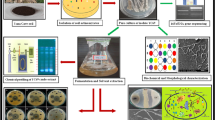Abstract
The production of paecilotoxin from various isolates of Paecilomyces lilacinus was studied using three different media and high performance liquid chromatography (HPLC). Alkaline medium was found to be suitable for the production of the toxins. Among 20 strains tested, 19 including four clinical isolates were found to produce the toxins. Production patterns of paecilotoxins were very similar in each strain and the main toxins were A and B.
Similar content being viewed by others
References
Rockhill RC, Klein MD. Paecilomyces lilacinus as the cause of chronic maxillary sinusitis. J Clin Microbiol 1980; 11: 737–739.
Maslen M, Whitehead J, Forsyth WM, McCracken H, Hocking AD. Systemic mycotic disease of captive crocodile hatching (Crocodylus porosus caused by Paecilomyces lilacinus. J Med Vet Mycol 1988; 26: 219–225.
Arai M, Mikami Y, Fukushima K, Utsumi T, Yazawa K. A new antibiotic, leucinostatin, derived from Penicillium lilacinum. J Antibiot 1973; 26: 157–161.
Mikami Y, Fukushima K, Arai T, Abe F, Shibuya H, Ommunra Y. Leucinostatins, peptide mycotoxins produced by Paecilomyces lilacinus and their possible roles in fungal infections. Zbl Bakt Hyg 1984; 257: 275–283.
Stroh JG, Rinehart KL, Cook JC, Kihara T, Suzuki M, Arai T. Identification and structure assignment of components of leucinostatin and CC-1014 by directly coupled liquid chromatography/fast atom bombardment mass spectrometry. J Amer Cheni Soc 1986; 108: 858–859.
Mori Y, Suzuki M, Fukushima K, Arai T. Structure of leucinostatin B, an uncoupler on mitochondria. J Antibiot 1983; 36: 1084–1086.
Radics L, Kajatar-Peredy M, Gasinovi CG, Rossi C, Ricc M, Tuttobello L. Leucinostatins H and K, two novel peptide antibiotics with tertiary amine-oxide terminal group from Paecilomyces marquandii. Isolation, structure and biological activity. J Antibiot 1987; 40: 714–716.
Mikami Y, Fukushima K, Samson RA, Udagawa S, Arai T. Paecilotoxins, etiological agents of fungal infection. Proc. Xth ISHAM Congress, Barcelona. 1988; 128–132.
Samson RA. Paecilomyces and some allied hyphomycetes. Studies in Mycology No. 6: 1–119 (Centraalbureau voor Schimmelcultures, Baarn), 1974.
Author information
Authors and Affiliations
Rights and permissions
About this article
Cite this article
Mikami, Y., Yazawa, K., Fukushima, K. et al. Paecilotoxin production in clinical or terrestrial isolates of Paecilomyces lilacinus strains. Mycopathologia 108, 195–199 (1989). https://doi.org/10.1007/BF00436225
Accepted:
Issue Date:
DOI: https://doi.org/10.1007/BF00436225




